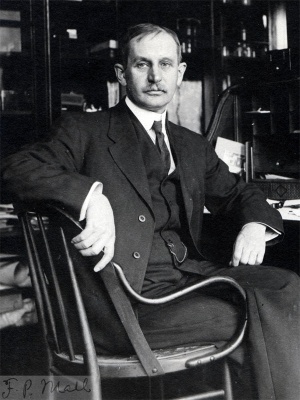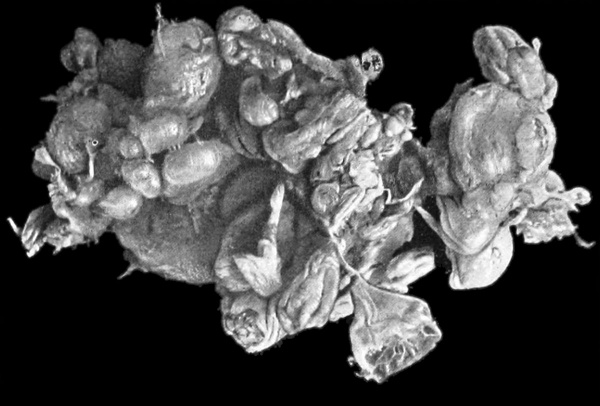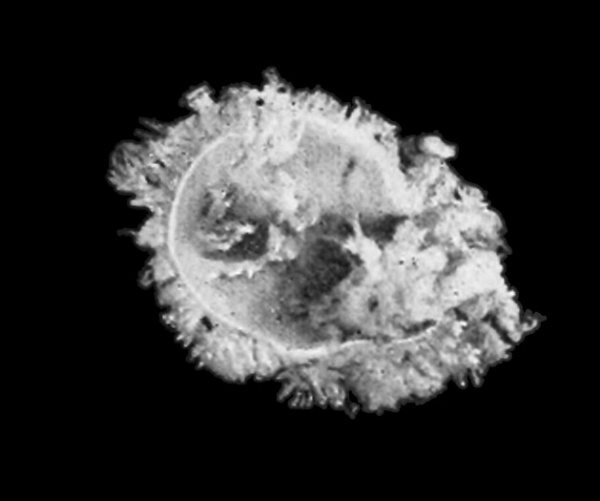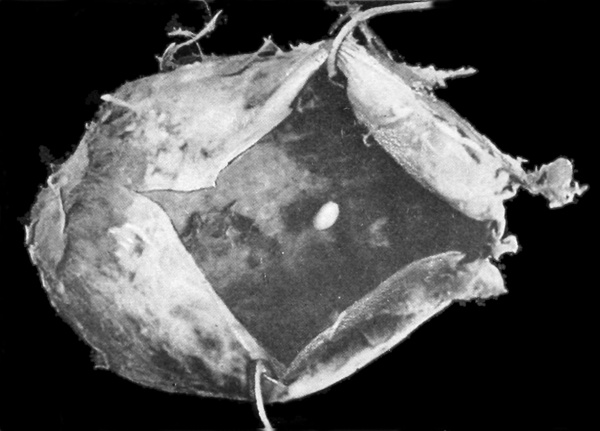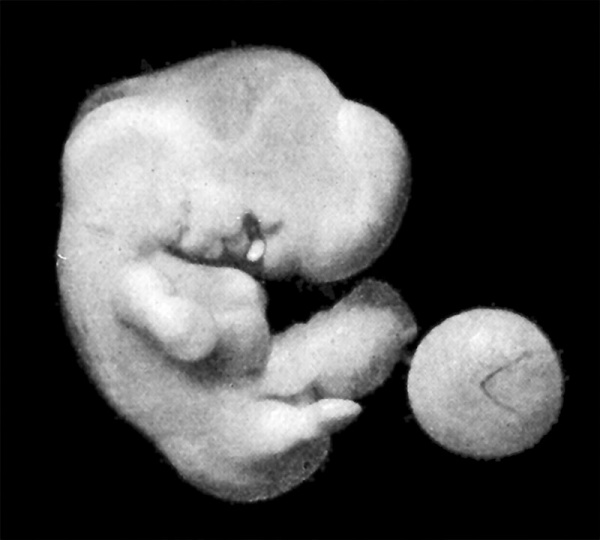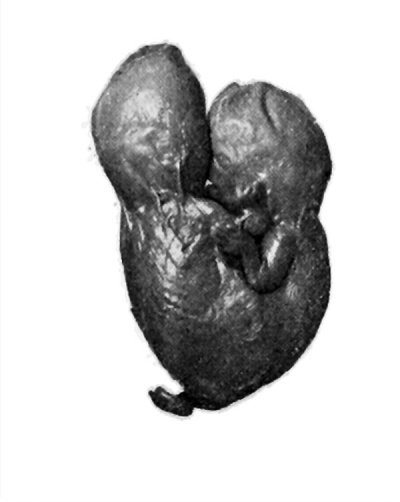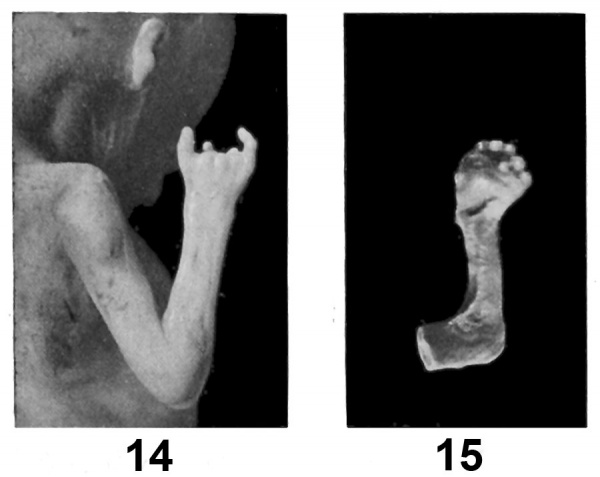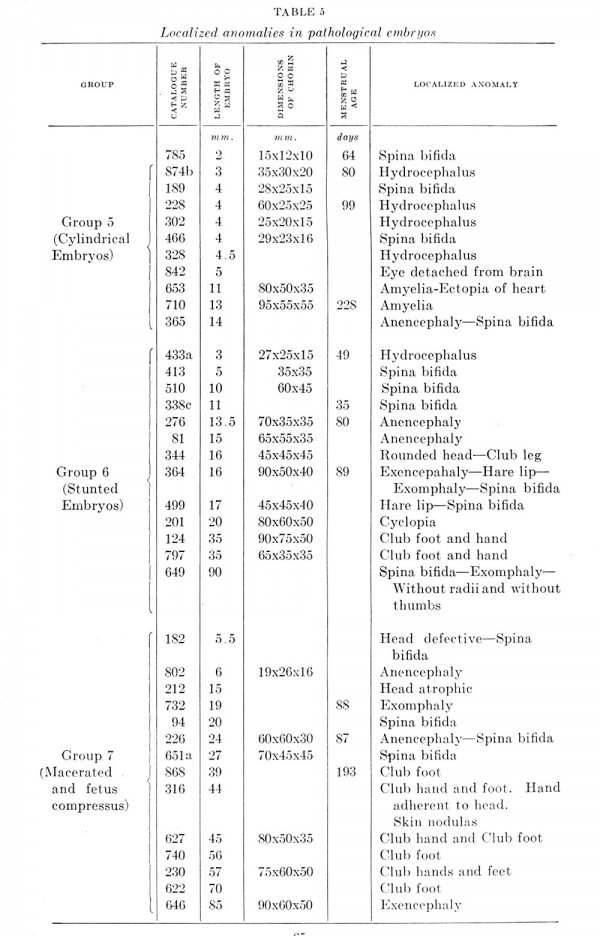Paper - On the Frequency of Localized Anomalies in Human Embryos and Infants at Birth
| Embryology - 1 May 2024 |
|---|
| Google Translate - select your language from the list shown below (this will open a new external page) |
|
العربية | català | 中文 | 中國傳統的 | français | Deutsche | עִברִית | हिंदी | bahasa Indonesia | italiano | 日本語 | 한국어 | မြန်မာ | Pilipino | Polskie | português | ਪੰਜਾਬੀ ਦੇ | Română | русский | Español | Swahili | Svensk | ไทย | Türkçe | اردو | ייִדיש | Tiếng Việt These external translations are automated and may not be accurate. (More? About Translations) |
Mall FP. On the frequency of localized anomalies in human embryos and infants at birth. (1917) Amer. J Anat. 22:49-72.
| Historic Disclaimer - information about historic embryology pages |
|---|
| Pages where the terms "Historic" (textbooks, papers, people, recommendations) appear on this site, and sections within pages where this disclaimer appears, indicate that the content and scientific understanding are specific to the time of publication. This means that while some scientific descriptions are still accurate, the terminology and interpretation of the developmental mechanisms reflect the understanding at the time of original publication and those of the preceding periods, these terms, interpretations and recommendations may not reflect our current scientific understanding. (More? Embryology History | Historic Embryology Papers) |
- In this historic 1917 pathology paper, figures and plates of abnormal embryos are not suitable for young students.
Online Editor - Please note the term "monster" is the historic term for gross developmental abnormalities and is both no longer used and also offensive. It has been left within this text as this is how such major abnormalities were medically referred at that time, and I apologise for any offence this term may cause.
On The Frequency of Localized Anomalies in Human Embryos and Infants at Birth
Amer. Jour. Anat., (1917) vol. 22, p. 49-72. Eighteen Figures
In a paper published nine years ago on the causes underlying the origin of human monsters, I made the assertion that localized anomalies were more common in embryos obtained from abortions than in the full term fetus, without, however, adducing conclusive evidence in support of this theory.[1] In a footnote on page 27 of that publication I gave a list of embryos with their chief defects, comparing them with the percentage of frequency of monsters born at full term. An objection to be raised to such a statement is the fact that there is not a complete correspondence between anomalies in the embryo and those found in the fetus at the end of pregnancy. For instance, spina bifida in young embryos is always complete while at full term the open canal is covered over with skin. Cyclopia and exomphaly are the same in the embryo as at birth, but the deformities of the head and neck of the embryo are of such a nature that it cannot live long enough to admit of comparison with like malformations found at term. With these difficulties clearly before me, I have made an effort to define sharply the anomalies in embryos, so that a satisfactory comparison might be made with those found in monsters at the end of pregnancy, as described in the literature.
I shall mention first cyclopia, for it seems to me that it is the type of monster which is now best understood. This clearer conception is due largely to the excellent experimental work of Stockard, and partly to the fact that the cyclopean state can exist quite independently of other marked deformities of the embryos. T haAo previously discussed tho question of cyclopia in a separate puhlication, and it is not therefore necessary for me to dilate further upon it at present."- Hare lip is also sharply defined in the embryo and is as readily recognized as exomphaly. Other anomalies, however, are more difficult to recognize as sharply defined malformations in the embryo.
We have in our collection about 2000 embryos. The pathological specimens of the first 400 were reported in my paper on the origin of human monsters mentioned above. Since the collection was taken over by the Carnegie Institution of Washington, it has gTown at a very rapid rate, about 400 specimens being added to it each year. I have in preparation a more extensive study of pathological embryos, and during the past year have practically completed a careful study of the first thousand. While this was in progress, another thousand specimens were added to the collection. At present, however, only the first thousand will be considered, the remainder not having been sufficiently tabulated to be of statistical value.
We have introduced and are gradually perfecting a system of classification of the embryos which will enable us to locate any specimen in our collection and the record thereof by means of a card catalogue. Reasons for adopting this system were given in a circular recently published.[2][3] The specimens can clearly be divided into two groups according to their origin, i.e., uterine and ectopic. In both of these, the embryos which are normal in form are catalogued according to their sitting height, which we call crown-rump (CR). All embryos therefore which are apparently normal, say 10 mm. long, are entered upon one card. What happens to these specimens subsequently, whether they are dissected, sectioned or preserved permanently as whole specimens, may also be entered upon this card without interference with the system of classification. The chief difficulty is to determine what constitutes a normal embryo, and here we must rely largely upon our experience in human and in comparative embryology. A sharply defined, well formed white embryo, with blood vessels shining through its transparent tissues, is considered normal. If it is partly stunted and opaque or disintegrating, it is considered pathological. A further study of the normal embryo, however, shows that in many of these specimens the membranes are decidedly pathological. For instance, the villi may be deformed, diseased, atrophic or hypertrophic, or the contents of the amnion and the exocoelom may be unusual. Nevertheless, in all of these cases we still classify the embryos as normal, although fully cognizant of the fact that the surrounding membranes are pathological; otherwise it would be difficult to account for the great number of spontaneous abortions. The theory is that the embryo was developed under pathological conditions, but that the chorion was not sufficiently affected to cause any apparent change in the embryo. If an embryo included in this group is apparently normal in all respects save one, we still consider it normal with a localized anomaly. In fact we are gradually forced into this position, as an embryo, considered at first to be normal, may later on prove to have a localized anomaly, such as spina bifida or cyclopia. As far as we can determine, such an embryo would have been able to survive longer had not something happened to its membranes, thus causing its expulsion. I am inclined to believe that pregnancies of this sort, if carried to term, would produce the ordinary monsters described by teratologists. As the study of our collection of specimens is continued by different members of the staff, localized anomahes, wlien found, are recorded in our card catalogue, without, as stated above, necessitating any rearrangement. WTien these anomalies are present in normal embryos, the embryos are classed as normal, with localized anomalies.
The second group of specimens, which are termed pathological, are in a way more interesting, and their study justifies our method of classifying localized anomalies with normal embryos. We have in this group a variety of changes ranging from those found in fetus compressus down to complete disintegration of the ovum, leaving only a few villi. Having made numerous efforts to classify these specimens, I have finally resolved them into seven groups which I shall consider in their reverse numerical order.
The seventh group, shown in figure 7, is composed mostly of larger specimens which are either dried up and deformed, or macerated and soft. These, of course, apparently merge into each other, and for this reason we have had to consider them as a single group. We hope, however, in the course of time to be able to subdivide them, for it is well known that fetus compressus is extremely rare in pigs and other lower animals, while edematous and macerated embryos are quite common. It appears that the type of fetus in this group develops as a normal embryo during the first portion of pregnancy, and then dies slowly, either undergoing maceration, or being transformed into a fetus compressus. In the latter the cord is long, thin and greatly twisted The structures of the embryo show that there has been a slow^ tissue growth which has not been sufficiently rapid to allow the normal development of the extremities. Instead the hands and feet are club-shaped, and in several instances there are adhesions between the extremities and the body We also find very pronounced and quite characteristic changes in the placenta of the fetus compressus, there being between the villi large masses of chromatin substance presenting much the same picture as the photograph of a comet, a central nucleus with scattered granules extending from it. Generally in our notes we speak of this substance as nuclear dust.
The sixth group of specimens we term stunted (fig. 6). The form of the embryo is easily recognized, but the head is atrophic as are also usually the extremities. At the time of the abortion the tissues are quite transparent, giving every appearance of a living embryo, but with, increasing knowledge concerning tissue cultures and growing isolated cells, we can see in specimens of this sort an active but circumscribed tissue culture of a clump of differentiated tissues. In other words we have a tissue culture of the entire embryo, which on account of faulty or arrested circulation, growls in an irregular manner. Changes of this sort ill an embryo I have designated in my paper on monsters as a dissociation of the tissues. I picture to myself something likelike the following sequence: when the ovum comes into the uterus which is more or less diseased, it becomes somewhat poisoned and consequently does not implant itself well. This naturally results in an irregular growth of the chorionic villi; in turn the embryo is affected and it is only natural to infer that the most direct influence would be through the vascular system, soon ending in poisoning of the heart and frequently in the interruption of the circulation. In such specimens the nutrition would reach the embryo through the exocoelom. In fact one of the earliest indications of a pathological specimen is an increased amount of magma in the exocoelom. Embryos, which are thus cut off from the chorion, continue to grow in an irregular manner; the tissues are more or less dissociated, and the specimen as a w^hole is stunted. Hence the designation.
In the fifth group (fig. 5), the process of stunting has progressed to such an extent that the extremities are almost entirely lacking and only the head end can be recognized with certainty. On account of their shape, due to this extreme stunting, we speak of these specimens as cylindrical embryos. Falling frequently into this group are embryonic remnants which, however, really do not belong there, since a primary examination with a binocular microscope does not permit of a sharp differentiation between this and other cylindrical forms of stunted embryos. Close examination with a microscope reveals specimens of this sub-group to be, composed of a naked umbilical cord belonging to an older embryo which had disintegrated, or as seen in a few instances the embryo has been torn off by mechanical means during abortion. As rapidly as the sub-type is recognized, it is labeled in the card catalogue in parenthesis (cord) so that in studying these specimens we may distinguish between the naked cords and the true cylindrical forms of pathological embryos.
When the process of dissociation of the embryo begins in still earlier stages than those belonging to the older groups (Nos. 0, 6, and 7), the result is a nodular body representing the embryo, Imt the cliango in it is so complete that it is difficult to recognize the different parts of the embryo except in a general way (fig. 4). The coelom, heart and central nervous system can readily be made out. Sometimes there are pigmented spots in one or two of the sections, marking the position of the eyes. This group again divides into two quite sharply circumscribed sub-groups: first, those with an umbilical cord to which the dissociated embryo is attached together with the umbihcal vesicle; and second, a vesicular group composed of specimens in which there is only the remnant of the umbilical vesicle, the embryo being nearly or entirely destroyed. Had it been possible in every instance to differentiate between these two types of specimens in the primary examination, they would, of course, have been recorded as separate groups; but this could not be done without sections and a microscopic examination. Therefore, for the present we must consider them together. In our ordinary laboratory parlance we speak of them as the nodular group.
In the third group, both embryo and umbilical vesicle are completely destroyed, but we can see within the degenerated chorionic sac a more or less complete amnion. This group is designated as the one in which the specimens are composed only of the chorion and the amnion (fig. 3).
In the second group the amnion is destroyed and there remains only the chorionic vesicle containing the coelom. This is usually filled with reticular magma and scattered cells, which may represent all that is left of the embryo (fig. 2).
Finally in the first group the form of the ovum is destroyed and the specimen consists only of the \dlli which have undergone fibrous or mucoid degeneration. Sometimes only a few of the \dlli are found, at other times there is a large cluster clinging to a single stem, and some specimens are composed of large masses of villi which form malignant hydatidiform moles. Such a mass may weigh a kilogram (fig. 1).
It can be readily seen that the above classification into subgroups is arranged somewhat in the order of the age of the ovum when it began to degenerate. Generally these changes are so pronounced that the embryo cannot live through the duration of pregnancy and this accounts for the abortion.
As far as localized anomalies are concerned, we naturally do not find them in the first four groups, while in the remaining three groups we encounter only such as are very pronounced and stand out clearly in spite of other changes in the embryo.
Figure 1
Fig. 1 Illustrating (Group 1, composed exclusively of villi. Specimen No. 749 received from Dr. G. C. McCormick. Sparrows Point, Md. X 2. These hypertrophic villi came from a hydatidiform mole weighing over a kilogram.
Figure 2
Fig. 2 Illustrating Group 2, chorion with coelom. No. 12S9 from Dr. J. R. Cottell, Louisville, Ky. X 2. The picture shows the coelom filled mostly with granular magma.
Figure 3
Fig. 3 Illustrating Group 3. chorion with amnion. No. 813 from Dr. H. D. Taylor, Baltimore. X i The cavity of the ovum is filled with a dense mass of granular magma.
Thus, for instance, with fetus compressus we frequently recognize club-foot; in stunted forms, hare lip and spina bifida, and in cylindrical forms, spina bifida. Of course, if cyclopia is encountered in any of these forms, it is looked upon as a localized anomaly in a pathological embryo. On the other hand, a single anomaly in an embryo called normal can easily be recognized, and it is from this group that we should expect the development of monsters had the pregnancy progressed to term.
Figure 4
Fig. 4 Specimen illustrating Group 4. The ovum contains a nodular embryo; Ko. 1140b from Dr. George T. Tayler, Greenville, S. C. X U
Figure 5
Fig. 5 Illustrating Group 5. Ovum containing a cylindrical embryo; No. 839 from Dr. W. S. Miller, Madison, Wis. X li
A few illustrations of localized anomalies are given in the figures in order to show that they are identical with those found in infants at birth. Figures 8 and 9 are specimens of cyclopia and double monsters in normal embryos. Figure 10 a and 10 b show an embryo and a fetus with hare lip. Figure 11, 12 and 13 have pronounced localized anomalies and need no further explanation. Finally figures 14 to 18 show anomalies of the hand the first and last are of the hereditary variety, and figures 15 and 16 show acquired anomalies, that is, they were subsequently formed in an embryo which started its development normally. It is proper to remark here that these illustrations are mostly from specimens from the second thousand of our
collection but this is for the reason that recently we have made many more photographs and secondly, many of the specimens in the first thousand have already been figured in my paper on monsters.
Figure 6
Fig. 6 Group 6. Three stunted embryos to illustrate this group. 6a, No. 1295d from Dr. B. T. Terry, Brooklyn, N. Y. X 4. 6b, No. 1523 from Dr. G. B. Ward, Gilman, Iowa. X 2. 6c, No. 1477 from Dr. H. B. Titlow, Baltimore. X 3.
In order to render possible a comparison between localized anomalies found in pathological and those found in normal embryos, the following six tables have been constructed. Table 1 gives the classified distribution of the first 1000 embryos in the Carnegie Collection. The primary division comprises two classes — pathological and normal. The pathological in turn is arranged in the seven groups just described. The normal are arranged in groups to correspond as nearly as possible with the ages of the embryos in lunar months. In order to define clearly which embryos belong to a given month, I have inserted their probable lengths for each month in table 6. Thus, for instance, the second month includes all specimens from 2.6 mm. to 25 mm. in length, etc. (Data upon the estimated age of embryos may be found in my chapter on the age of embryos, contained in the Manual of Human Embryology.[4] It will be noted in these tables that the specimens are arranged in centuries; that is, each line in the table includes exactly 100 specimens. The first century includes specimens Nos. 1 to 98, the second, Nos. 99 to 205, and so on. This adjustment was necessary for the reason that frequently a single number is given to two or more specimens. Sometimes the first is called a and the second, b; or the first may be given the number, and the second the letter a, etc. The second century passing from Nos. 99 to 205 includes more than 100 numbers, because specimens which are given a number are frequently found upon further examination not to contain any remnants of the ovum, and for this reason they are to be discarded. In our catalogue they are later marked as 'no pregnancy.' Finally the full 1000 ends with embryo No. 900g. The individual entries are percentage records. Thus in the fifth century, there are 41 normal specimens of the second month; that is, of this hundred, 41 per cent of the specimens are normal embryos of the second month, whereas the total for the full 1000 has been brought down this percentage to 24.5.
Figure 7
Fig. 7 Group 7, giving two specimens of fetus compressus. 7a, No. 996 from Dr. H. B. Titlow, Baltimore, X r. 7b, No. 868 from Dr. E. H. Egbert, Washington. X 2.
Figure 8
Fig. 8 Normal embryo with cyclopia; in front of the eye is seen the Cyclopean snout. No. 559 from Dr. B. J. Merrill, Stillwater, Minn. X 5.
Figure 9
Fig. 9 Normal double monster. No. 249 from Prof. L. Hektoen, Chicago. Natural size.
Figure 10
Fig. 10 Two specimens of hare lip. 10a, No. 364 from Dr. B. .1. Merrill, Stillwater, Minn. X 3. There is also exencephaly in this specimen. 10b, No. 9S2 from Dr. G. C. McCormick, Sparrows Point, Md. X 2.
Figure 11-13
| Fig. 11 Stunted fetus with a large hernia in umbilical cord, also spina bifida. No. 1330 from Dr. A. R. Mackenzie, Capitol Heights, Md. X H. | Fig. 12 Normal embryo with exencephaly and spina bifida (the latter opposite the arrow). No. 1315 from Dr. J. C. Bloodgood, Baltimore, X 2. | Fig. 13 Normal fetus with hernia of midbrain. No. 1690 from Dr. P. F, Williams, Philadelphia. X 9.10. |
Figure 14-15
| Fig. 14 Anomaly of the left hand in which only the thumb and little finger are normal. No. 306a from Dr. F. A. Conradi, Baltimore. X f. | Fig. 15 Left hand which is club-shaped from a fetus compressus. No. 230, CR 57 mm., from the late Dr. J. P. West, Bellaire, Ohio. Natural size. |
Figure 16-18
| Fig. 16 Deformed wrist with atrophic radius in a normal embryo. No. 789, CR 50 mm., from Dr. H. F. Cassidy, Roland Park, Aid. X 2. The same kind of wrist is seen in the specimen illustrated as figure 11. | Fig. 17 Right hand with six fingers from macerated specimen. No. 1749 from Dr. S. M. Wagaman, Hagerstown, Md. X 2. This specimen had six digits on all four extremities. | Fig. 18 Double little finger of the left hand of the same specimen. X 2. |
Table 1
In determining the normality of specimens, the criterion used was the shape of the embryo, judging this as best we could by our own knowledge of human and comparative embryology, as well as by the experience of other students of human embryology, and we have used freely the atlases of His, Hichstetter and Keibel and Else in making our decisions on this point. However, many of these specimens are enclosed in membranes which have undergone very marked changes. Thus, an embryo, normal in form, may be found surrounded by an excessive amount of magma, and the chorion may have undergone very pronounced changes; but for purposes of classification we have found it necessary to arrange them all according to the shape of the embryo. A fairly large number of our specimens were obtained from hysterectomies, and we believe with Hochstetter that we shall ultimately have to determine what constitutes a normally formed human embryo from specimens obtained in this way. However, even by this method we have found among about 25 specimens 3 markedly pathological ones undergoing abortion.
Table 2
The second table includes all specimens that were obtained from the uterus, and the third, all ectopic specimens. Thus, in making a comparison of these three tables it will at once be noted that among the entire 1000 nearly 40 per cent are pathological embryos and ova. Of this number, 31 per cent were obtained from the uterus alone while slightly more than 8 per cent were ectopic. The comparative frequency of pathological and normal embryos can be ascertained, however, by comparing them within a given century, or for the whole thousand together. In the uterine specimens about one-third of the ova and embryos are pathological, as compared to two-thirds in the ectopic. In other words, pathological specimens are twice as frequent in ectopic as in uterine pregnancy.
Table 3
Table 4
The fourth table includes all the specimens in which there are pronounced localized anomalies. The character of the anomaly is given with the individual specimens which are recorded in tables 5 and 6. It is interesting to note that these tables show that there are about as many anomalies among the normal as among the pathological specimens, but when these figures are compared with the total of specimens both normal and pathological, it becomes evident that localized anomalies occur about twice as frequently in the pathological as in the normal embryo. Thus, there are 38 localized anomalies among 396 pathological specimens or about 10 per cent, while the occurrence of localized anomalies in 604 normal specimens is about 6 per cent. The table shows further that the 38 pathological specimens with localized anomalies abort in the early part of pregnancy and only one of them (No. 649) grew to a sitting height of 90 mm., that is, about the middle of the fourth month.
Among the normal embryos, those with localized anomalies usually disappear before the fifth month, there being but one in the sixth, one in the eighth, and four in the tenth month or at the end of pregnancy. In other words, all pathological specimens, either with or without localized anomalies, abort in the first half of pregnancy ; while nearly all so-called normal embryos with slight malformations are also aborted before the middle of pregnancy, very few of them reaching full term.
Table 5
Table 6
We have made an especial effort to collect specimens of full term monsters as well as abortion material from all months of pregnancy. Only the first 100 specimens of the collection show an unusually large percentage of normal embryos. Although at first an effort was made to collect only good normal specimens the last 900 specimens, including all sorts of material, of the collection carry about the same percentage of normal specimens throughout. The first 1000 specimens of our collection is short of fetuses from the second half of pregnancy, but we are now endeavoring to collect material covering all months of pregnancy. One monster at term, a sympus belonging in about the third hundred, was not recorded in our catalogue, and should be added to the four full term specimens given in table 4. This means that among 1001 specimens there were five monsters at term, while among 1000 specimens there were 71 with localized anomalies, most of which w^ere aborted early in pregnancy.
According to the table on the frequency of abortions given in my monograph on monsters,[5] there are 80 full term births for each 20 abortions; therefore, the 1000 abortions under consideration were probably derived from 5000 pregnancies.
As we have calculated that there should be approximately 30 full term monsters in 5000 pregnancies, and as 5 of these were observed in our 1000 specimens, it is apparent that the remaining 25 should be encountered in 4000 additional full term births. When these figures are compared with the fact that 75 localized anomalies occurred in 1000 abortions — 7.5 per cent, it becomes apparent that in any similar numbers of abortions, localized anomalies should be noted twelve times as frequently as monsters at term. A similar result is obtained if the number of localized anomalies of the tenth month, as given in table 4, is compared with all of the localized anomalies of previous months, as given in the same table.[6]
Our studies seem to justify the conclusion that pathological embryos, as well as those which are normal in form, are very frequently associated with localized anomalies and that abortion usually follows as a result of serious lesions in the chorion, as well as in its environment. Should the alterations in the embryo and in the chorion be very slight, and the condition of the uterine mucous membrane, which may be expressed by the term inflammation, be overcome, the pregnancy in all probability would go to term and end in the birth of a monster or an infant presenting a well recognized malformation.
I have already pointed out the difference in, frequency of malformations and destructive changes as observed in the ovum in tubal and in uterine pregnancies. Since the publication of my monograph on monsters, I have reconsidered the question of tubal pregnancy, and the specimens mentioned in the present paper are recorded in detail in a book on tubal pregnancy recently published.[7] It seems to me that the studies based upon our collection of embryos as well as recent investigations in experimental embryology, set at rest for all time the question of the causation of monsters. It has been my aim to demonstrate that the embryos found in pathological human ova and those obtained experimentally in animals are not analogous or similar, but identical. A double monster or a cyclopean fish is identical with the same condition in human beings. In all cases, monsters are produced by external influences acting upon the ovum; as, for instance, varnishing the shell of a hen's egg or changing its temperature; traumatic and mechanical agencies magnetic and electrical influences, as well as by alteration of the character of the surrounding gases, or by the injection of poisons into the white of an egg. In aquatic animals, monsters may be produced by similar methods. Whether in the end all malformations are brought about by some simple mechanism, such, for instance, as alteration in the amount of oxygen or some other gas, remains to be demonstrated. The specimens under consideration show such marked primary changes in the villi of the chorion and in the surrounding decidua that the conditions in the human may be considered equivalent or practically identical with those created artificially in the production of abnormal development in animals.
It would have been quite simple to conclude that the poisons produced by an inflamed uterus should be viewed as the sole cause, but when it is recalled that pathological ova occur far more commonly in tubal than in uterine pregnancy, such a theory becomes untenable. Moreover, monsters are frequently observed in swine and other animals without any indication of an inflammatory environment. For this reason I have sought the primary factor in a condition buried in the non-committal term fault}^ implantation. It would seem to be apparent that lesions occurring in the chorion as the result of faulty implantation, can and must be reflected in the embryo. For example, before circulation has developed, in a human embryo, pabulum passes from the chorion to the embryo directly through the exocoelom, and probably on this account we always encounter, as a first indication of pathological development, a change in the magma. In older specimens before any other changes are noticeable in the ovum, the magma become markedly increased, and a variety of changes are found between the villi. I shall not dwell further upon magma as I have recently dealt with the subject in detail.[8]
It is perfectly clear that monsters are not due to germinal and hereditary causes, but are produced from normal embryos by influences which are to be sought in their environment. Consequently, if these influences are carried to the embryo by means of fluids which reach it either before or after the circulation has become established, it would not be very far amiss to attribute these conditions to alterations in the nutrition of the embryo. Probably it would be more nearly correct to state that change in environment has affected the metabolism of the egg. Kellicott, who has recently discussed this question, seems to be disinclined to accept such an explanation, but I do not see that he has added materially to it by substituting the word disorganization for nutrition as one might as easily say that the altered nutrition causes the disorganisation.[9]
In my paper on monsters I stated that on account of faulty implantation of the chorion the nutrition of the embryo is affected, so that, if the ovum is very young the entire embryo is soon destroyed, leaving only the umbilical vesicle within the chorion, and this also soon disintegrates, leaving only the chorionic membrane which in turn collapses, breaks down and finally disappears entirely. In older specimens, on the other hand, the process of destruction takes place more slowly and thus we account for a succession of phenomena which correspond with the seven groups of pathological ova recognized and given in the various tables appended.
In my original study, I really went, I believe, a step farther than Kellicott in his discussion of monsters, as he dropped the subject by stating that the embryo is a monster simply because it is disorganized. I attempted to analyze the process of disorganization more thoroughly and demonstrated that when disorganization begins it is accompanied by cytolysis, but as it progresses more rapidly it results in histolysis, and that these two processes do not act with equal severity on all parts of the embryo. When we consider the whole ovum, it is the embryo itself which is first destroyed; while within the embryo the central nervous system or the heart is the portion which is first affected. Morphologically, these changes are accompanied by a destruction of certain cells and tissues, leaving other portions which continue to grow in an irregular manner. For this reason I speak of the tissues which are first affected as more susceptible than the others. The entire process of disorganization, resulting in an irregular product, I have termed dissociation. In a general way this explanation is accepted by Werber in his recent studies, but he employs the term blastolysis instead.[10]
At the time I prepared my paper on monsters, Harrison was just beginning his interesting experiments in tissue culture in our laboratory. Since then this method of study has given us clearer insight into the independent growth of tissues. I was fully convinced from the study of pathological embryos that tissues continue to grow in an irregular manner, thus arresting normal development; but since we are more familiar with the growth of tissues, as revealed by Harrison's method, we can understand a little better the process of dissociation. In fact we have in our collection two striking examples of tissue culture in human embryos. In one, the cells had formed an irregular mass which is growing actively, but the contour of the organs has been entirely lost. In the other, from a tubal pregnancy, for some unknown reason, the ovum had been completely broken into two parts, which in turn had cracked the embryo, and from each piece had been a vigorous independent tissue growth, or, as we may now say, a tissue culture. Accordingly, when an embryo through changed environment is profoundly affected, the development of one part of the body may be arrested, while the remaining portion may continue to grow and develop in an irregular manner. In very young embryos tissues or even entire organs become disintegrated, as can easily be recognized by the cytolysis and histolysis present, and the resultant disorganized tissue cannot continue to produce the normal form of an embryo. If this process is sharply localized, for instance, in a portion of the spinal cord or in the brain, spina bifida or anencephaly results. To produce a striking result, as in cyclopia, a small portion of the brain must be affected at the critical time, and I think the work of Stockard has shown clearly that this is before the eye primordia can be seen. Consequently, in order to produce a human monster, which is to live until the end of gestation, the altered environment must be reflected from the chorion to the embryo, so that the tissue to be affected is struck at the critical time in its development. It is inconceivable that cyclopia should begin in an embryo after the eyes are once started in normal development. Moreover, the same is true regarding hare lip, for after the upper jaw has once been well formed, the abnormality cannot develop. We may extend this statement to include club-foot, spina bifida occulta, and other types of malformation. In fact, in discussing the origin of merosomatous monsters, hardly more has been stated by most authors than that there has been an arrest of development, but I have attempted to point out that the primary cause is in the environment of the egg and that the arrested development is associated with destruction of tissue.
References
- ↑ Mall FP. A study of the causes underlying the origin of human monsters. (1908) J Morphol. 19: 3-368.
- ↑ Mall, F. P. Cyclopia in the human embryo. Contributions to Embryology, vol. 6, Publication No. 226, Carnegie Institution of Washington, 1917.
- ↑ Mall, F. P. Embryological collection of the Carnegie Institution, Circular No. 18, 1916.
- ↑ Determination of the age of human embryos and fetuses. Human Embryology, Keibel and Mall, vol. 1, Chap. 8. 1910.
- ↑ Also in a resume of the paper on monsters in the article entitled: Mall, F. P. Pathology of the human ovum. Chapter 9, Human Embryology, Keibel and Mall, vol. 1, 1910.
- ↑ Records are now being made of about 50,000 births in Baltimore, including the frequency of abortions for each mother. When these are completed, the above mentioned ratio of 1 to 4 will probably be changed.
- ↑ Mall, Franklin P. On the fate of the human embryo in tubal pregnancy. Publication No. 221, Carnegie Institution of Washington, 1915.
- ↑ Mall, Franklin P. On magma reticule in normal and in pathological development. Contributions to Embryology, vol. 4, Publication No. 224, Carnegie Institution of Washington, 1916.
- ↑ Kellicott, W. E. The effect of lower temperature upon the development of Fundulus. Am. Jour. Anat., vol. 20, 1916.
- ↑ Werber, E. I. Experimental studies aiming at the control of defective and monstrous development. A survey of recorded monstrosities with special attention to the ophthalmic defects. Anat. Rec, vol. 9, 1915. Also: Blastolysis as a morphogenetic factor in the development of monsters. Anat. Rec, vol. 10, 1916.
| Historic Disclaimer - information about historic embryology pages |
|---|
| Pages where the terms "Historic" (textbooks, papers, people, recommendations) appear on this site, and sections within pages where this disclaimer appears, indicate that the content and scientific understanding are specific to the time of publication. This means that while some scientific descriptions are still accurate, the terminology and interpretation of the developmental mechanisms reflect the understanding at the time of original publication and those of the preceding periods, these terms, interpretations and recommendations may not reflect our current scientific understanding. (More? Embryology History | Historic Embryology Papers) |
Cite this page: Hill, M.A. (2024, May 1) Embryology Paper - On the Frequency of Localized Anomalies in Human Embryos and Infants at Birth. Retrieved from https://embryology.med.unsw.edu.au/embryology/index.php/Paper_-_On_the_Frequency_of_Localized_Anomalies_in_Human_Embryos_and_Infants_at_Birth
- © Dr Mark Hill 2024, UNSW Embryology ISBN: 978 0 7334 2609 4 - UNSW CRICOS Provider Code No. 00098G

